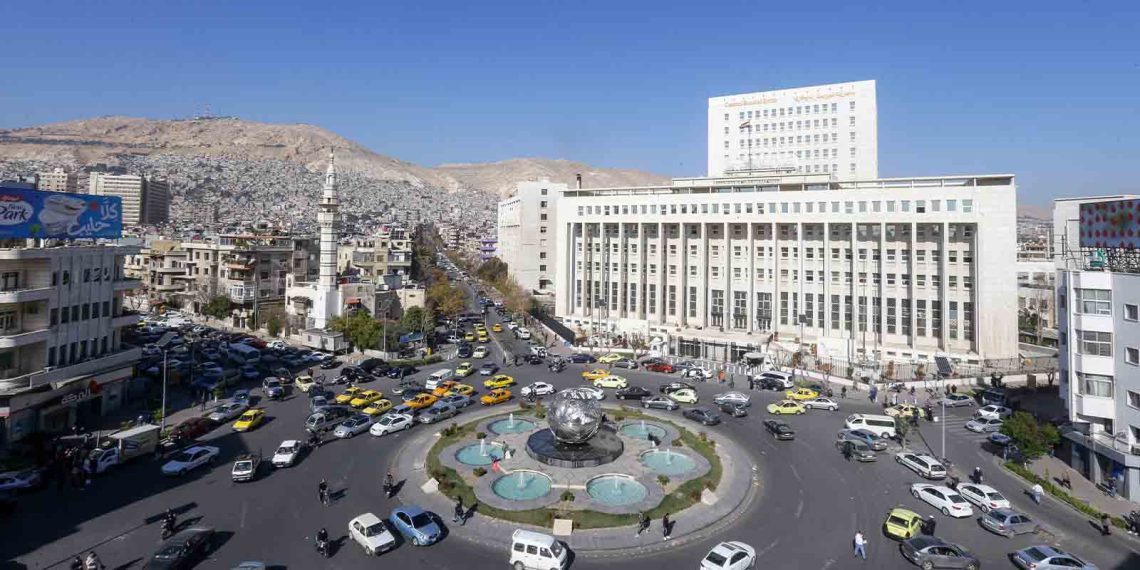The United States has submitted a list of demands and conditions to the Syrian government, many of which have been leaked to the press and described by American officials as part of a “confidence-building” process. These demands come at a time when the US administration has yet to finalise its position on the new Syrian leadership that assumed power following the ousting of Bashar al-Assad on 8 December 2024.
Although a US State Department spokesperson told the Wall Street Journal last Thursday that “the United States does not currently recognise any entity as the Syrian government,” Washington has issued limited-entry visas to select Syrian officials. Among them are Finance Minister Muhammad Yusr Barnieh and Central Bank Governor Abdul Qader Hasriya, who are attending the IMF and World Bank spring meetings in Washington this week. Syrian Foreign Minister Assaad al-Shibani has also been granted a visa to participate in a UN Security Council session on Syria this Friday in New York.
Details of the American Demands
According to The Washington Post, during an international meeting in Brussels last month, a mid-level official from President Donald Trump’s administration handed Syrian Foreign Minister Assaad al-Shibani a document listing eight “confidence-building” steps. These measures are presented as prerequisites for the partial easing of sanctions.
Among the demands: permission for the United States to conduct counterterrorism operations on Syrian soil against any target it deems a national security threat; a public declaration banning all Palestinian factions and political activities within Syria; and the deportation of their members to alleviate Israeli concerns. Syria is also required to officially endorse the international coalition against ISIS.
Reuters later confirmed that Deputy Assistant Secretary of State Natasha Franceschi delivered the list to Shibani during a private meeting at the Syria donor conference in Brussels on 18 March. The demands also included the destruction of remaining chemical weapons stockpiles, rejection of foreign military figures in leadership roles within the Syrian administration, and cooperation on locating missing American journalist Austin Tice by appointing a liaison officer to support US efforts.
Initial US Engagement and Sanctions Relief
Barbara Leaf, Assistant Secretary of State under former President Joe Biden, met with Syrian President Ahmad al-Sharaa shortly after Assad’s fall. She described the meeting as “positive” and said it addressed Syria’s transition, regional developments, the fight against ISIS, and the fate of Tice and other US nationals who disappeared under the previous regime. Following this meeting, Washington withdrew a $10 million bounty on Sharaa, who had previously led Hay’at Tahrir al-Sham, after US officials deemed him “pragmatic.”
In a significant gesture, Washington temporarily eased sanctions on Syria for six months to avoid obstructing essential services and to support the continuity of governance, including water, energy, and public sanitation.
Over the weekend, President Sharaa and Minister Shibani met with US Congressman Cory Mills at the People’s Palace in Damascus. Mills, joined by Congresswoman Marilyn Strickland and members of the Syrian American Alliance for Peace and Prosperity (SAAP), was on a fact-finding visit to assess the situation in post-Assad Syria. Mills stated that the lifting of US sanctions would require numerous steps and affirmed that Washington seeks “a reality where stability prevails and a democratically elected Syrian government emerges.”
Damascus’s Response and Washington’s Assessment
According to political researcher Radwan Ziadeh, the Syrian government submitted a four-page written response to the American demands. Speaking to Al-Araby Al-Jadeed, Ziadeh said the Biden administration is now reviewing Damascus’s reply, adding that initial impressions are “positive.”
Former Syrian diplomat Bassam Barabandi described the demands as “realistic,” noting that several conditions have already been implemented—particularly those targeting Iranian presence and affiliated militias. He further stated that ISIS activity has been “virtually eliminated” since Assad’s fall, and that transitional justice and inclusive governance are priorities for Syrians themselves.
An Ambiguous American Position
Despite ongoing engagement, the United States maintains an ambiguous stance towards Syria’s new leadership. Syrian political analyst Muayed Ghazzal criticised this lack of clarity, stating that American policy remains hindered by “hesitation and indecision.” He argued that many US demands have already been met, including the dismantling of Palestinian factions within Syria, which he said are no longer active. According to Ghazzal, “There will be no armed groups of any nationality operating in Syria that threaten neighbouring countries. This has been Syria’s declared policy since liberation.”
He also warned that some demands infringe on Syria’s sovereignty, particularly the condition allowing Washington to conduct unilateral strikes on Syrian soil. “This is a sovereign matter,” he said, “and Syria alone determines its counterterrorism partnerships. Combating extremism is a Syrian priority, not just an international one, and Damascus aligns with the global community on this front.”
While Ghazzal described some demands—such as cooperation on chemical weapons—as reasonable and already in progress, he argued that conditional diplomacy from afar is counterproductive. “Dialogue must be direct,” he said. “The Syrian people will always choose sovereignty first, even if sanctions continue. Realism and mutual respect must guide future US engagement with Syria.”
US Troop Reduction and Regional Impact
The US Department of Defense announced last Friday that it would begin consolidating its military presence in Syria. The Pentagon stated that the process would be “deliberate and conditional,” aiming to reduce troop numbers to below 1,000 over the coming months. The United States currently has around 2,000 troops stationed at various bases across Syria, most of them in the northeast under the control of the Syrian Democratic Forces (SDF), the primary ground force partner in the international coalition against ISIS.
A US withdrawal from northeastern Syria could dramatically alter the balance of power, potentially shifting control of resource-rich territories from the SDF to Damascus. Washington is therefore pressing for serious negotiations between the two sides to determine the region’s political future before the final withdrawal of American forces.
This article was translated and edited by The Syrian Observer. The Syrian Observer has not verified the content of this story. Responsibility for the information and views set out in this article lies entirely with the author.


